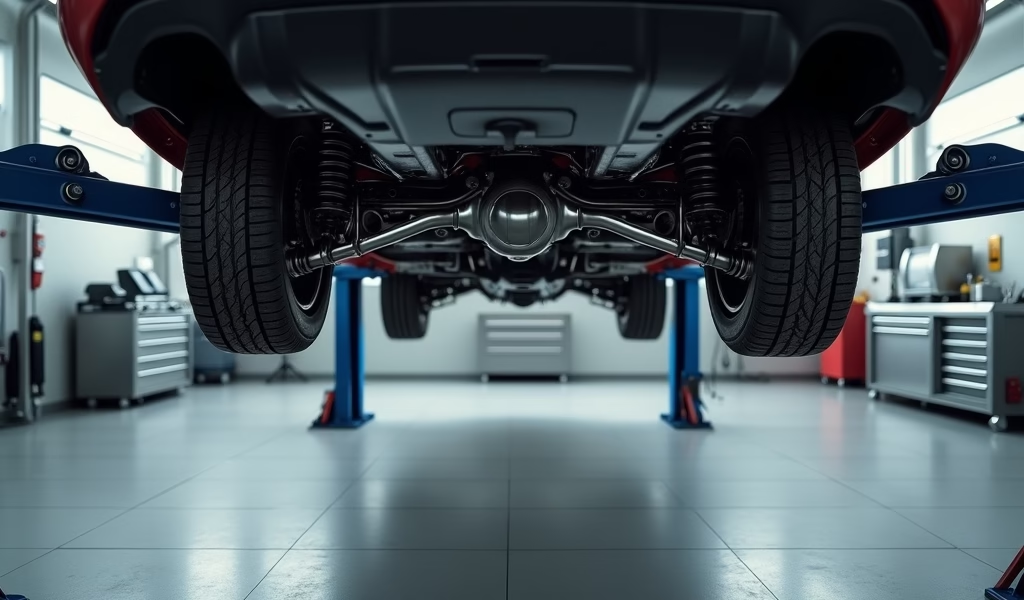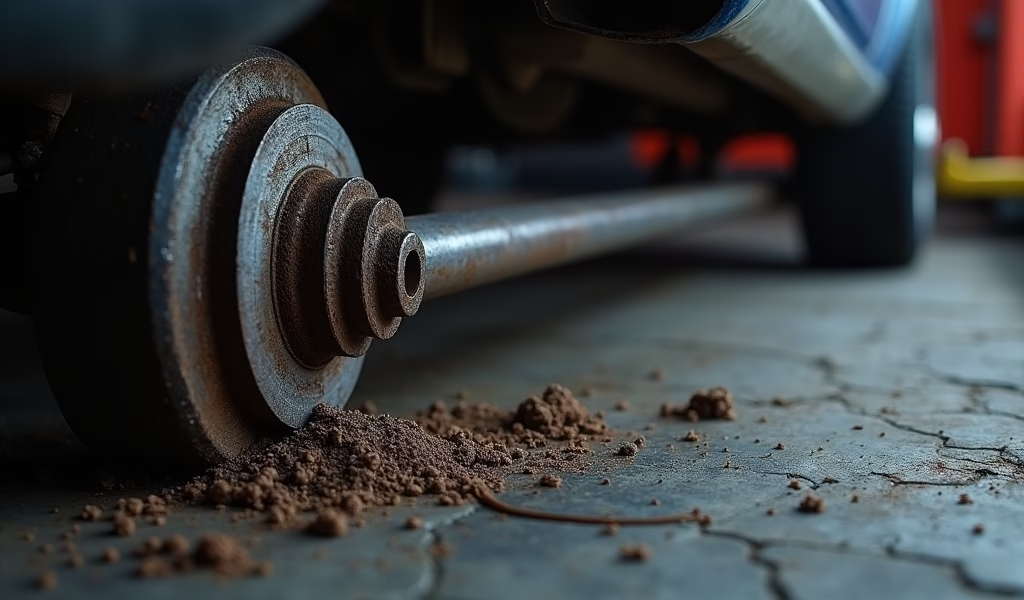Overview
This guide explains how to identify, measure, and prevent axle shaft spline wear through seven key inspection techniques including visual assessment, lubrication checks, and load testing. Regular maintenance of these critical drivetrain components can prevent catastrophic failures, with the article providing specific maintenance intervals and clear indicators for when to repair versus replace worn splines.
Table of Contents
- Understanding Axle Shaft Splines
- Why Spline Wear Matters
- Visual Inspection Techniques
- Measuring Spline Wear
- Checking Lubrication
- Assessing Related Components
- Load Testing Procedures
- Preventative Maintenance Schedule
- When to Replace vs. Repair
- Conclusion
- Frequently Asked Questions
Understanding Axle Shaft Splines
I’ve been under countless vehicles during my 20+ years as a mechanic, and if there’s one drivetrain component that doesn’t get enough attention, it’s axle shaft splines. These tooth-like ridges might seem simple, but they’re the unsung heroes transferring power from your transmission to your wheels.
Axle shaft splines are precision-engineered teeth that mesh with corresponding grooves in components like differentials, hubs, and CV joints. Every time you press your gas pedal, these tiny teeth are hard at work. Think of them as nature’s power connectors – similar to how a bee’s legs perfectly grasp pollen, these splines create a secure connection while still allowing slight movement.
The genius of spline design is in its ability to transfer massive torque loads while accommodating the slight movements and flexing that occur during normal driving. Without properly functioning splines, your vehicle’s power delivery would be unpredictable at best, dangerous at worst.
Why Spline Wear Matters
Let’s get straight to the point – neglected spline wear can leave you stranded. I’ve seen it happen countless times. A customer ignores a slight clicking noise during acceleration, only to end up with a vehicle that won’t move despite the engine running perfectly.
Spline wear happens gradually. Like a slow leak in your roof, you might not notice anything until significant damage has occurred. The metal teeth slowly round off, creating slop in the drivetrain that gets progressively worse.
When splines wear, several issues emerge:
- Unpredictable power delivery (especially noticeable during acceleration)
- Clicking or clunking noises when shifting between drive and reverse
- Vibrations that seem to change with speed or load
- Complete drivetrain failure in severe cases
The cost difference between preventative maintenance and emergency repair is substantial. I’ve helped customers save hundreds by identifying early spline wear during routine inspections, rather than replacing entire axle assemblies after catastrophic failure.
Driving with worn splines isn’t just a mechanical concern – it’s a safety issue. Imagine accelerating to merge onto a highway when your drivetrain suddenly loses engagement. This scenario isn’t theoretical; I’ve had customers towed in after exactly this situation.

Visual Inspection Techniques
Visual inspection is your first line of defense against axle shaft spline problems. You don’t need fancy tools to spot the early warning signs – just some basic knowledge and attention to detail.
Start by safely supporting your vehicle and removing the wheels. Depending on your vehicle, you might need to remove brake components or CV axles to access the splines. If you’re not comfortable with this process, consider having a professional handle the inspection.
Once you’ve gained access, here’s what to look for:
- Rounded edges on spline teeth (they should have sharp, defined edges)
- Uneven wear patterns (some teeth more worn than others)
- Metal particles or shavings around the spline area
- Discoloration indicating overheating (bluish tint)
- Cracks or chipping at the base or tips of splines
Use a good flashlight to illuminate the splines from different angles. Small wear patterns are easier to spot when light hits them at various angles. A shop mirror can help you see the back side of splines in tight spaces.
Before making your assessment, clean the splines thoroughly with brake cleaner and a brush. Old grease and road grime can mask important wear indicators. I’ve seen perfectly good splines condemned and worn splines missed simply because they weren’t properly cleaned before inspection.
Take photos during your inspection – they’re invaluable for tracking wear progression over time. A simple smartphone camera works perfectly for this purpose.
Measuring Spline Wear
When visual inspection raises concerns, precise measurement becomes your next step. You don’t need expensive specialized tools to get useful data – a good digital caliper will do the trick for most DIY mechanics.
Here’s my proven process for measuring spline wear:
- Clean the splines thoroughly with brake cleaner
- Measure the width of several spline teeth at the same position on each
- Measure the width of several valleys between teeth
- Compare measurements from different positions around the shaft
- Check for consistency in measurements around the entire circumference
If you find variations greater than 0.005″ between similar measurements, that’s a red flag for uneven wear. Ideally, you’d compare your measurements against factory specifications, but these can be hard to find. Instead, I often recommend measuring a new or known-good part for comparison.
When measuring, be methodical – I number the splines with a marker and record measurements in a notebook. This documentation becomes invaluable for tracking wear over time. It’s like monitoring your blood pressure – regular readings help you spot concerning trends before they become emergencies.
For those who want to go deeper, a professional spline wear analysis guide can provide more detailed measurement techniques. These guides often include acceptable wear tolerances for different vehicle applications.
Checking Lubrication
Proper lubrication is to splines what blood is to your body – absolutely essential for survival. In my decades as a mechanic, I’d estimate that 80% of premature spline failures can be traced back to improper lubrication.
When checking spline lubrication, look for these key indicators:
- Presence of adequate lubricant (splines should be coated, not dry)
- Condition of the lubricant (it should be clean, not contaminated)
- Consistency (not excessively thinned or hardened)
- Evidence of metallic particles (indicates active wear)
Different vehicle manufacturers specify different lubricants for splines. Most passenger vehicles use molybdenum disulfide grease, often called “moly grease.” This special lubricant creates a bond with the metal surface that withstands extreme pressure better than ordinary grease.
If you’re reapplying lubricant, don’t just slap it on haphazardly. I like to use a small brush to work the grease into all the spline surfaces evenly. This ensures complete coverage and helps displace any moisture that may be present.
Remember that over-greasing can be as problematic as under-greasing. Excessive grease can capture contaminants and actually accelerate wear. Apply enough to coat the surfaces without creating thick globs that will just get thrown off during rotation.
If you find your splines frequently lacking lubrication, investigate potential seal failures. A damaged seal can allow lubricant to escape and contaminants to enter. The CV joint boot condition is particularly important to check during your inspection.

Assessing Related Components
Splines rarely wear in isolation. In my experience, there’s usually an underlying cause or related component issue that’s contributing to the problem. That’s why a thorough inspection should extend beyond just the splines themselves.
Here are the key related components to check:
- CV joints for play or binding
- Differential bearings and gears
- Wheel bearings for excessive play
- Mounting points for security and alignment
- Seals for leaks or damage
- Universal joints for wear or looseness
I’ve seen many cases where a customer replaced worn splines only to have the new ones fail prematurely because the root cause wasn’t addressed. For instance, a failing wheel bearing creates abnormal movement that can accelerate spline wear dramatically.
Pay special attention to vibrations during your assessment. Vibrations are the symptom that connects many drivetrain issues. If you detect vibrations that change with speed or load, consider consulting the vehicle vibration diagnosis guide to pinpoint the source.
Don’t overlook the basics: check for proper axle nut torque and retention. An under-torqued axle nut allows movement that can destroy splines in short order. I’ve fixed many “mysterious” drivetrain issues by simply applying the correct torque to axle components.
Load Testing Procedures
Static inspection only tells part of the story. To truly assess spline condition, you need to observe how they perform under load. I’ve developed some safe load testing procedures that don’t require special equipment.
Here’s how you can perform basic load testing:
- With the vehicle safely supported and in neutral, rotate the wheel/hub by hand while watching for movement at spline connections
- Look for any “play” or delayed engagement when changing direction of rotation
- Have an assistant slowly apply and release the brake while you rotate the wheel to add resistance
- During a test drive, note any clunking or popping during acceleration and deceleration
- Listen carefully when shifting between drive and reverse – this transition often reveals spline problems
One of my favorite diagnostic techniques is what I call the “throttle test.” With the vehicle safely supported on jack stands and wheels off the ground, have an assistant very gently apply throttle while you observe the drivetrain components. Use extreme caution with this test – just enough throttle to slightly rotate the wheels is all you need.
Pay attention to temperature effects during your testing. I’ve diagnosed many intermittent spline issues that only appear after components heat up during operation. What looks fine in your cold garage might behave differently after 20 minutes of highway driving.
Remember that worn splines often produce subtle symptoms before catastrophic failure. A slight hesitation during acceleration or a barely perceptible click might be your only warning of impending problems.
Preventative Maintenance Schedule
An ounce of prevention is worth a pound of cure – especially when it comes to axle splines. Based on my experience, here’s a practical maintenance schedule that balances thoroughness with practicality:
- Every oil change: Visual inspection of accessible CV boots and seals
- Every other tire rotation: Check for unusual wear patterns that might indicate drivetrain issues
- Every 30,000 miles: Thorough inspection of splines including cleaning and re-lubrication
- After driving through deep water: Inspect and re-lubricate splines (water contamination accelerates wear)
- Whenever unusual drivetrain noises develop: Immediate inspection
If you frequently drive in severe conditions (off-road, through water crossings, or pulling heavy loads), shorten these intervals accordingly. I’ve seen pristine splines on 200,000-mile vehicles and destroyed splines on 20,000-mile vehicles – maintenance matters more than mileage.
Keep a simple maintenance log. It doesn’t need to be fancy – just dates, mileages, and brief notes about what you observed and did. This history becomes invaluable for identifying patterns and predicting when components might need attention.
Don’t forget the simple maintenance items that protect your splines indirectly. Things like maintaining proper tire pressure and regular differential fluid changes contribute significantly to spline longevity.
When to Replace vs. Repair
The million-dollar question: repair or replace? In my shop, I use these guidelines to help customers make informed decisions:
- Minor wear (less than 10% material loss): Clean, lubricate, and monitor
- Moderate wear (10-25% material loss): Replace if cost-effective, otherwise monitor closely
- Severe wear (over 25% material loss): Replace immediately
- Any cracking or chipping: Replace without question – these are failure indicators
Unlike some components, splines generally can’t be “repaired” in the traditional sense. There are specialized welding and building-up processes, but these are rarely cost-effective for everyday vehicles. In most cases, replacement is the practical solution.
When replacement becomes necessary, consider these options:
- New OEM components (most reliable but most expensive)
- Quality aftermarket parts (good balance of cost and reliability)
- Rebuilt/remanufactured assemblies (cost-effective for older vehicles)
- Used parts (lowest cost but highest risk)
My advice? Don’t skimp on drivetrain components. The price difference between budget and quality parts is typically small compared to the labor involved. Having to do the job twice because of a part failure is both expensive and frustrating.
Remember that replacing one component often necessitates checking related parts. When I replace axle shaft splines, I always inspect the mating component as well. Worn splines in one component often create accelerated wear in their mates.
Conclusion
After inspecting thousands of vehicles over my career, I’ve found that axle shaft spline wear is one of the most overlooked yet potentially serious issues in vehicle maintenance. These humble components work tirelessly to transfer power from your engine to your wheels, and they deserve regular attention.
The seven inspection tips we’ve covered provide a comprehensive approach to monitoring and maintaining your vehicle’s axle splines:
- Visual inspection techniques
- Measuring wear accurately
- Checking lubrication
- Assessing related components
- Performing load tests
- Following a preventative maintenance schedule
- Knowing when to replace versus repair
By incorporating these practices into your regular maintenance routine, you can avoid the frustration and expense of unexpected breakdowns. Remember that most catastrophic failures don’t happen suddenly – they develop gradually, often with subtle warning signs that can be detected through careful inspection.
If you’re not comfortable performing these inspections yourself, don’t hesitate to ask your mechanic to specifically check spline condition during your next service. A good technician will appreciate your attention to detail and awareness of these critical components.
Keep your vehicle rolling smoothly by giving these hidden heroes the attention they deserve. Your axle splines might not be visible during daily driving, but their condition has a direct impact on your vehicle’s reliability, safety, and longevity. A small investment in preventative maintenance today can save you from costly repairs tomorrow.
Frequently Asked Questions
What causes axle shaft spline wear?
Axle shaft spline wear is primarily caused by insufficient lubrication, contamination, misalignment, and normal wear over time. Aggressive driving habits and overloading the vehicle can significantly accelerate the wear process.
How often should I inspect my axle shaft splines?
For most vehicles, inspect axle shaft splines every 30,000 miles or when you notice unusual drivetrain noises. Vehicles used in severe conditions (towing, off-road, etc.) should be inspected more frequently.
What are the warning signs of worn axle splines?
Common warning signs include clicking or clunking noises during acceleration or when shifting between drive and reverse, vibration during acceleration, and power hesitation. Complete power loss can occur in severe cases.
Can I drive with worn axle splines?
Driving with worn axle splines is not recommended as it can lead to unpredictable power delivery and complete drivetrain failure. The severity of the risk depends on the extent of wear, but it’s always safer to address the issue promptly.
Is axle shaft spline repair expensive?
The cost varies widely depending on your vehicle and whether related components need replacement. Addressing early wear through proper lubrication is inexpensive, while complete axle assembly replacement can cost several hundred dollars including labor.

